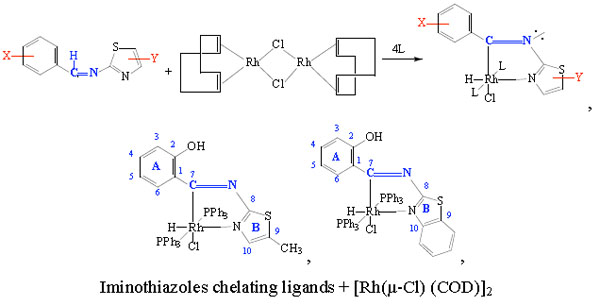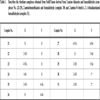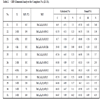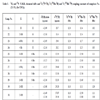- Home
- About Journals
-
Information for Authors/ReviewersEditorial Policies
Publication Fee
Publication Cycle - Process Flowchart
Online Manuscript Submission and Tracking System
Publishing Ethics and Rectitude
Authorship
Author Benefits
Reviewer Guidelines
Guest Editor Guidelines
Peer Review Workflow
Quick Track Option
Copyediting Services
Bentham Open Membership
Bentham Open Advisory Board
Archiving Policies
Fabricating and Stating False Information
Post Publication Discussions and Corrections
Editorial Management
Advertise With Us
Funding Agencies
Rate List
Kudos
General FAQs
Special Fee Waivers and Discounts
- Contact
- Help
- About Us
- Search

Open Chemistry Journal
(Discontinued)
ISSN: 1874-8422 ― Volume 8, 2021
Hydridothiazole Rhodium Complexes as a Result of C-H Bond Activation in Iminothiazoles Chelating Ligands
Jehan Al-hamidi1, Abdulhamid Alsaygh2, Ibrahim Al-Najjar2, *
Abstract
A series of 20 Schiff base ligands derived from 2-aminothiazole and its derivatives and aryl aldehydes with either [RhCl(PPh3)3] or [Rh(µ-Cl)(COD)]2 in the presence of 4 equivalents of PPh3 lead to an Rh(III) cyclometallated complex and the imine ligand (C-H) bond has been added to the metal (C-M-H). The complexes were investigated by using I.R., 1H, 13C and 31P NMR Spectroscopic techniques. The signal of the (C-H) ligand was observed as trans to the nitrogen atom in the complex which is a donor ligand.
Graphical Abstract:
Total synthesis of hydridothiazole rhodium complexes possessing rhodium hydride signal at δ (-14.60 to-15.04) ppm, trans to N-donor ligand and iminoyl carbon (7C=N) signal in Rh (III) observed at δ (220.1-237.6)ppm, lower field and suggestive of carbine like properties.

Article Information
Identifiers and Pagination:
Year: 2014Volume: 1
First Page: 27
Last Page: 32
Publisher Id: CHEM-1-27
DOI: 10.2174/1874842201401010027
Article History:
Received Date: 27/5/2014Revision Received Date: 30/10/2014
Acceptance Date: 18/11/2014
Electronic publication date: 31/12/2014
Collection year: 2014
open-access license: This is an open access article licensed under the terms of the Creative Commons Attribution Non-Commercial License (http://creativecommons.org/licenses/by-nc/3.0/) which permits unrestricted, non-commercial use, distribution and reproduction in any medium, provided the work is properly cited.
* Address correspondence to this author at the Petrochemicals ResearchInstitute, King Abdulaziz City for Science and Technology, P. O. Box 6086, Riyadh – 11442, Saudi Arabia; Tel: +966 504269199; E-mail; alnajjar@kacst.edu.sa
| Open Peer Review Details | |||
|---|---|---|---|
| Manuscript submitted on 27-5-2014 |
Original Manuscript | Hydridothiazole Rhodium Complexes as a Result of C-H Bond Activation in Iminothiazoles Chelating Ligands | |
1. INTRODUCTION
The oxidative addition of C-H bond activated by transition metal has been reported in many recent studies in organometallic chemistry [1Jonson, KRD; Hayes, PG Cyclometalative C?H bond activation in rare earth and actinide metal complexes Chem. Soc. Rev, 2013, 42, 1947-1960.
[http://dx.doi.org/10.1039/c2cs35356c] -4Lu, F; Li, J; Sun, H; Li, X Selective C-H bond activation of 1,2,4,5-tetrafluorobenzene by Co(PMe3)4 Inorganica Chimica Acta, 2014, 416, 222-225.
[http://dx.doi.org/10.1016/j.ica.2014.03.025] ]. Benzylic imines (Ph-CH = NR) are the most studied ligands in the cyclometallation of transition metals [5Benett, RL; Bruce, MI; Matsuda, I; Doednes, RJ; Little, RG; Veal, JT Ortho-metallation of a sulphur-donor ligand: preparation structure of C6H4CH3SMeMn(CO)2(PPH3) Journal of Organometallic Chemistry, 1974, 67(3), 19. C72-C74., 6Benett, RL; Bruce, MI; Stone, FGA Cyclometallation reactions XII On the effect of various leaving groups on internal metallation reactions with alkyl manganese complexes Journal of Organometallic Chemistry, 1975, 94(1), 65-74.
[http://dx.doi.org/10.1016/S0022-328X(00)82531-0] ]. It has been reported that intramolecular C-H activation examples of rhodium with N-donar ligands and C-X (X: halogen) activation with imines [2Deng, Y; Gong, W; He, J; Yu, J-Q Ligand-enable Triple C-H Activation Reactions: One -Pot Synthesis of Diverse 4-Aryl-2-Quinolinones from Propionamides Angewandte Chemie-International Edition, 2014, 53, 6692-6695.
[http://dx.doi.org/10.1002/anie.201403878] -4Lu, F; Li, J; Sun, H; Li, X Selective C-H bond activation of 1,2,4,5-tetrafluorobenzene by Co(PMe3)4 Inorganica Chimica Acta, 2014, 416, 222-225.
[http://dx.doi.org/10.1016/j.ica.2014.03.025] , 7Hill, AF Organotransition Metal Chemistry 2003, 22, 3566-3576.
[PMID: ISBN 10: 0854046224/0-85404-622-4] -9Krug, C; Hartwig, JF Imine Insertion into a late metal-Carbon Bond to Form a Stable Amido Complex Journal of the American Chemical Society, 2004, 126, 2694-2695.
[http://dx.doi.org/10.1021/ja038819a] ]. The first report of ortho-metallation of imines at rhodium via C-H activation has appeared only recently [2Deng, Y; Gong, W; He, J; Yu, J-Q Ligand-enable Triple C-H Activation Reactions: One -Pot Synthesis of Diverse 4-Aryl-2-Quinolinones from Propionamides Angewandte Chemie-International Edition, 2014, 53, 6692-6695.
[http://dx.doi.org/10.1002/anie.201403878] -4Lu, F; Li, J; Sun, H; Li, X Selective C-H bond activation of 1,2,4,5-tetrafluorobenzene by Co(PMe3)4 Inorganica Chimica Acta, 2014, 416, 222-225.
[http://dx.doi.org/10.1016/j.ica.2014.03.025] , 10Marcazzan, P; Patrick, BO; James, BR Rhodium (III)-cyclometalated-imine complexes: Solution behavior and reactivity with molecular hydrogen Organometallics., 2005, 24, 1445-1451.
[http://dx.doi.org/10.1021/om049121o] ]. Interestingly, cyclometallation reaction of imine [11El-Baih, FEM; Abu-Loha, FM; Gomaa, Z; Al-Najjar, IM Synthesis and characterization of some rhodium (III) cyclometallated complexes of 2-substituted benzylideneamino thiazoles Transition Metal Chemistry, 1994, 19, 325-328.
[http://dx.doi.org/10.1007/BF00139104] ] C-H bonds lead us to study some of the important chemistry related to the imines, derivatives from 2-aminothiazole and its derivatives and aryl aldehydes. In most recent application for ruthenium, rhodium and iridium complexes have been used as therapeutic agents and a number of kinetically inert ruthenium(II), iridium(III) and rhodium(III) complexes have been reported as inhibitors of protein kinases [12Leung, CH; He, HZ; Liu, LJ; Wang, M; Chan, DSH; Ma, DL journal title Coord. Chem. Rev, 2013, 257, 3139-3151.
[http://dx.doi.org/10.1016/j.ccr.2013.08.008] -16Leung, CH; Yang, H; Ma, VPY; Chan, DSH; Zhong, HJ; Li, YW; Fong, WF; Ma, DL Inhibition of janus kinase 2 by cyclometalated rhodium complexes Med. Chem. Comm, 2012, 3, 696-698.
[http://dx.doi.org/10.1039/c2md00306f] ]. Chung-Hang Leung and Dik-Lung Ma group have also actively pursued the development of kinetically inert metal complexes as inhibitors of various bimolecular targets, including DNA, enzymes and protein-protein interactions [13Zhong, HJ; Leung, KH; Liu, LJ; Lu, L; Chan, DS; Leung, CH; Ma, DL journal title Chem. Plus Chem, 2014, 79, 508-511.]. Here, we report the synthesis and characterization of many new rhodium (III) complexes of (X - (substituted benzylidene amino) thiazoles.
2 . MATERIAL AND METHODOLOGY
CHEMICALS: All techniques and all operations were performed under nitrogen using Schlenk techniques. Substituted aryl aldehydes, RhCl3. xH2O, Ph3P, cyclo-1, 5-octadien, and 2- aminothiazoles derivatives were purchased from Winlab, Aldrich and Strem chemicals, and were used as received.
2.1. SCHIFF BASES SYNTHESES:
The Schiff bases were synthesized by adding equivalent amounts of aryl aldehydes and 2-aminothiazole derivatives in 80 ml methanol. The resulting mixture was boiled under reflux and stirred for 9 h at 80°C in an oil bath, and then the solvent was concentrated by using rotary evaporation to give brown viscous liquid. Then n-hexane was added to precipitate the crude product, which was then recrystallized in dichloromethane and with n-hexane to give white precipitate, dried, yield 50-70% scheme (1 ), (the full characterization of the resulting Schiff base was submitted for publication in Arab Gulf Journal of Scientific Research (AGJSR), 2014.
), (the full characterization of the resulting Schiff base was submitted for publication in Arab Gulf Journal of Scientific Research (AGJSR), 2014.
 |
Scheme 1 Describes Schematic preparation and structural of iminothiazoles (1-20) chelating ligands. |
 |
Eq. (2) Compound (No.16), X = 2-OH. |
 |
Eq. (3) Compound (No.17):, X = H,(18), X = 2-OH,(19), X = 4-NO2, (20), X = 4-Br. |
2.2. SYNTHESES of the CYCLOMETALLATED SCHIFF BASE COMPLEXES.
The rhodium (III) complexes were synthesized by reaction of the Schiff base with either {RhCl(Ph3P)3} or [Rh (µ-Cl)(COD)]2. [17Giopdano, G; Crabtree, RH Di-p-chloro-bis (g4-115-cyclooctadiene)-dirhodium (1)" Inorg. Synth, 1974, 19, 318-220., 18Colquhonn, HM; Holton, J; Thompson Wigg, MV New pathways for Organic synthesis, Practical Application of Transition Metal Plenum Press: New York and London, 1984; pp. 380-390.
[http://dx.doi.org/10.1007/978-1-4613-2651-9] ]. Here, we report two examples:
- A solution of {Rh Cl(PPh3)3} (300 mg, 0.325 mmol) mixed with an equivalent amount of thiazole imines in 20 cm of dry THF was refluxed for1 h under nitrogen atmosphere, then allowed to cool. Addition of n-hexane precipitated the product, the resulting product gave yellow solid, which was separated and (recrystallized from CH2Cl2/hexane).
- A solution of {Rh(µCl)(COD)}2 (200 mg, 0.28 mmol), thiazole Schiff base (0.56 mmol) and PPh3 (293 mg, 1.12 mmol) in ca. 20 cm3 of dry THF was refluxed for 1 h, and by addition of n-hexane, the product was precipitated, which was separated by filtration and (recrystallized from CH2Cl2/hexane).
2.3. SPECTROSCOPY:
I.R. spectra were measured using Nexus spectrophotometer FT IR. The N.M.R. spectra were recorded at R.T. on a JEOL 400 MHz. The 1H, 13C (1H) and 31P [1H] -n. m. r. frequencies observated at 400, 100 and 161.08 MHz respectively (at JEOL). Positive values for 31P- [1H] representing deshielding. The cyclometallated complexes) were dissolved in CDCl3.
3. RESULTS AND DISCUSSION:
Introducing metal into C-H bond have been observed in many compounds like quinoline and Schiff base substrates [19Dehand, J; Pfeffer, M Cyclometallated compounds Coordination Chemistry Reviews, 1976, 18(3), 327-352.
[http://dx.doi.org/10.1016/S0010-8545(00)80431-2] ]. A significant amount of work has been done on the heterocyclic aromatic species, 8-substituted quinoline [20Albinati. A., Anklin; C.G., Ganazzoli; F., Ruegg H; Pregosin, PS Preparative and 1H NMR Spectroscopic Studies on Palladium (II) and Platinum (II) quinoline-8-carbaldehyde (1) Complexes. X-ray Structures of the Cyclometalated Acyl complex PdCI(C(O)C9H6N)Ph3)PPh3 and trans-P1Cl2 (I)(Pet3) Inorg. Chem, 1987, 26, 503-508.
[http://dx.doi.org/10.1021/ic00251a005] -24Dowerah, D; Radonovich, LJ; Woolsey, JF; Heeg, MJ Reaction of 2-(alpha-R-Benzylidene) amino) pyridines LBR equals CH3, 4-(CH3O), C6H4 with RhCl(L)3 or Rh2Cl2(CO)4. Formation and structure of a Rhodium (II) Dimer Organometallics, 1990, 9(3), 614-620.
[http://dx.doi.org/10.1021/om00117a014] ] and 2- (benzylidenamino) pyridines [25Sprouse, S; King, KA; Spellane, PJ; Watts, P; Richard, J Photophysical Effects of metal-carbon sigma bonds in Orthometalated complexes of Iridium (III) and Rhodium (III) J. Am. Chem. Soc, 1984, 106(22), 6647-6653.
[http://dx.doi.org/10.1021/ja00334a031] -29Suggs, JW; Chul-Ho, J Directed Cleavage of Carbon-carbon Bonds by Transition Metals: the alpha-bonds of ketones J. Amer. Chem. Soc, 1984, 106(10), 3054-3056.
[http://dx.doi.org/10.1021/ja00322a063] ]. Coordination of the metal with nitrogen atom in aryl amines results in a favorable geometry for introducing of the metal into neighboring C-H or C-C bond [21Suggs, JW; Wovkulich, MJ; Cox, SD Synthesis, structure and Ligand-promoted Reductive Elimination in an Acylrhodium Ethyl complex Orgtanometallics, 1985, 4(6), 1101-1107.
[http://dx.doi.org/10.1021/om00125a028] , 25Sprouse, S; King, KA; Spellane, PJ; Watts, P; Richard, J Photophysical Effects of metal-carbon sigma bonds in Orthometalated complexes of Iridium (III) and Rhodium (III) J. Am. Chem. Soc, 1984, 106(22), 6647-6653.
[http://dx.doi.org/10.1021/ja00334a031] , 26Perera, SD; Shaw, BL; Thornton-Pett, M General Strategy for Inducing C?H bond fission (Cycloirradiation) in some Aryl, Heterocyclic, alkenyl or alkyl groups in azines derived from aldehydes or methyl Ketones J. Chem. Soc. Dalton Trans, 1995, 10, 1689-1696.
[http://dx.doi.org/10.1039/dt9950001689] , 30Albinati, A; Arz, C; Pregosin, PS Structure and NMR Spectroscopy of some Rhodium (III) Cyclometalated Schiff's Base complexes Derived from 2-Benzylidene-3-methypyridines. Crystal Structure of (RHHI (2(3-nitrobenzylidene)-3-methyl-pyridine) (RhHI(2-(3nitrobenzyli-dene)-3-methyl-pyridine)(PPh3)2). J. Organomet. Chem, 1987, 35(3), 379-394.]. Rhodium complexes (Table 1)
were synthesized either by mixing and refluxing equimolar amount of the Schiff base with {RhC1(Ph3P)} in THF for 0.5h [31Janecki, T; Jeffreys, JAD; Pauson, PL; Pietrzykrowski, A; McCullough, KJ Bis-Orthometalated Palladium Complexes, New Examples and Reactivity The X-ray Crystal Structure of cis-(2-C6H6N-NC6H6)2 Pd and cis-(2-C6H6N-NC6H6)) (2-Me6nCH2C6H6)Pd Organometallics, 1987, 6, 1553-1560.], or by boiling a solution of one equivalent of {Rh(µ-Cl)(COD)}2, with two equivalents of prepared Schiff base with four equivalents of phosphine in THF for 1h, as showed in Scheme (2 ). The 1H NMR spectrum of each of the new rhodium complexes in CDCl3 shows a hydride resonance between δ -11.49 and δ -13.27 ppm (Table 3). The signals of the starting Schiff bases, C-H observed at δ 8.20-9.44 ppm and in the resulting complex, these signals are absent, providing evidence for insertion of Rh complex into the C-H bond of the imines. Strong confirmation evidence comes from appearance of the resonance of the hydride signal in each complex at high field [24Dowerah, D; Radonovich, LJ; Woolsey, JF; Heeg, MJ Reaction of 2-(alpha-R-Benzylidene) amino) pyridines LBR equals CH3, 4-(CH3O), C6H4 with RhCl(L)3 or Rh2Cl2(CO)4. Formation and structure of a Rhodium (II) Dimer Organometallics, 1990, 9(3), 614-620.
). The 1H NMR spectrum of each of the new rhodium complexes in CDCl3 shows a hydride resonance between δ -11.49 and δ -13.27 ppm (Table 3). The signals of the starting Schiff bases, C-H observed at δ 8.20-9.44 ppm and in the resulting complex, these signals are absent, providing evidence for insertion of Rh complex into the C-H bond of the imines. Strong confirmation evidence comes from appearance of the resonance of the hydride signal in each complex at high field [24Dowerah, D; Radonovich, LJ; Woolsey, JF; Heeg, MJ Reaction of 2-(alpha-R-Benzylidene) amino) pyridines LBR equals CH3, 4-(CH3O), C6H4 with RhCl(L)3 or Rh2Cl2(CO)4. Formation and structure of a Rhodium (II) Dimer Organometallics, 1990, 9(3), 614-620.
[http://dx.doi.org/10.1021/om00117a014] , 29Suggs, JW; Chul-Ho, J Directed Cleavage of Carbon-carbon Bonds by Transition Metals: the alpha-bonds of ketones J. Amer. Chem. Soc, 1984, 106(10), 3054-3056.
[http://dx.doi.org/10.1021/ja00322a063] ] ca. δ -12.38 ppm. The hydride signals in the complexes are split by coupling to an equivalent of two 31P nuclei and the 103Rh nucleus. The spin-spin couplings are frequently ca. 12.0 Hz, the hydride multiplet observed as a pseudo quartet, but higher resolution frequency are usually appear as the expected doublet of triplets. The 31P, of rhodium complexes show a 31P signal at ca. δ 28.2-37.78 with 1J (103Rh-31P) 102.00-120.00 Hz as a doublet (Table 3) in keeping with previous report [30Albinati, A; Arz, C; Pregosin, PS Structure and NMR Spectroscopy of some Rhodium (III) Cyclometalated Schiff's Base complexes Derived from 2-Benzylidene-3-methypyridines. Crystal Structure of (RHHI (2(3-nitrobenzylidene)-3-methyl-pyridine) (RhHI(2-(3nitrobenzyli-dene)-3-methyl-pyridine)(PPh3)2). J. Organomet. Chem, 1987, 35(3), 379-394.]. The majority of the rhodium imines hydride complexes are only moderately soluble in chloroform-d and dichlomethane-d2 solvents (complexes are soluble in DMSO, but decomposed during NMR processing).
 |
Scheme 2 Describes schematic diagram for preparation of “hydridothiazole” rhodium complexes. |
The 13C 1H NMR spectrum, in particular the signal from the metal- carbon bonded atom, is consistent with the presence of the cyclometallated ring [24Dowerah, D; Radonovich, LJ; Woolsey, JF; Heeg, MJ Reaction of 2-(alpha-R-Benzylidene) amino) pyridines LBR equals CH3, 4-(CH3O), C6H4 with RhCl(L)3 or Rh2Cl2(CO)4. Formation and structure of a Rhodium (II) Dimer Organometallics, 1990, 9(3), 614-620.
[http://dx.doi.org/10.1021/om00117a014] , 31Janecki, T; Jeffreys, JAD; Pauson, PL; Pietrzykrowski, A; McCullough, KJ Bis-Orthometalated Palladium Complexes, New Examples and Reactivity The X-ray Crystal Structure of cis-(2-C6H6N-NC6H6)2 Pd and cis-(2-C6H6N-NC6H6)) (2-Me6nCH2C6H6)Pd Organometallics, 1987, 6, 1553-1560., 32Giordano, G; Crabtree, RH Di-mu-chloro-bis (eta 4-1, 5-cyclooctadiene) dirhodium(I) Inorg. Synth, 1979, 19, 218-220.
[http://dx.doi.org/10.1002/9780470132500.ch50] ] the signal from the metal-bonded carbon, C (7) (iminoyl carbon-13C=N) appears as a doublet of triplets owing to coupling to two equivalent 31P nuclei and the 103Rh nucleus, whereas the corresponding signal from the uncomplexed Schiff base was found at δ 159.25-164.97 ppm [24Dowerah, D; Radonovich, LJ; Woolsey, JF; Heeg, MJ Reaction of 2-(alpha-R-Benzylidene) amino) pyridines LBR equals CH3, 4-(CH3O), C6H4 with RhCl(L)3 or Rh2Cl2(CO)4. Formation and structure of a Rhodium (II) Dimer Organometallics, 1990, 9(3), 614-620.
[http://dx.doi.org/10.1021/om00117a014] ]. For C (7), δ- has been observed at low-field position in which a chelating atom is incorporated in a five member-ring [33Colquhonn, HM; Holton, J; Thomspon, DJ; Wigg, MV New Pathways for Organic Synthesis. Practical Application of Transition Metals Plenum Press: New York, 1984.
[http://dx.doi.org/10.1007/978-1-4613-2651-9] ], and this was expected for a cyclometallated sp2 carbon [11El-Baih, FEM; Abu-Loha, FM; Gomaa, Z; Al-Najjar, IM Synthesis and characterization of some rhodium (III) cyclometallated complexes of 2-substituted benzylideneamino thiazoles Transition Metal Chemistry, 1994, 19, 325-328.
[http://dx.doi.org/10.1007/BF00139104] , 34Pregosin, PS; Kunz, RW NMR Basic Principle and progress Berlin: Springer Verlag, 1979.] (similar to carbene-carbon. The remaining 1H and 13C NMR data are as expected. Table 4, demonstrate the 13C-NMR chemical shifts for C (7) (iminoyl carbon-13C=N), and coupling constants 1J (103Rh-31P) Hz and 2J (103Rh-31P) Hz. Complex No. X, C (7) (ppm) 1J (103Rh-31P) (Hz) 2J (103Rh-31P) (Hz), respectively. No. 21, X = H; 220.1; 33; 8. No 22; X = 2-OH; 222.8; 32; 8. No.23; X = 4-NO2; 224.1; 33. 8 .No. 24; X = 4-Br; 222.0 ; 32.0; 9 .The positions of the Rh-H signals in both IR (v Rh-H) 2073.48 cm-1 for compound (24) and 1H NMR (δ -11.49 to -13.27 ppm) spectra, are as expected for a Rh-H bond located trans to the nitrogen-donor ligand. In addition, the 2J (31P-1H) value is consistent with a hydride located cis to two magnetically equivalent of PPh3 groups [35Pregosin, PS; Kunz, RW Phosphorus-31 and Carbon-13 NMR of transition metal phosphine complexes NMR Basic Principle and Progress Berlin: Springer Verlag, 1979.-37Garrow, PE ?R ring Contribution to 31P NMR Parameters of Transition-Metal-Phosphorus Chelate Complexes Chem. Rev, 1981, 81, 229-266.
[http://dx.doi.org/10.1021/cr00043a002] ], which in turn are mutually trans, as confirmed from the 13P (1H) NMR spectrum. Interestingly, the hydride 1H NMR spectrum of compound (31) presented in two type of the hydride spectrum which appear at δ -11.49 ppm and -12.36 ppm. Also, two 31P-spectrum appears at δ 37.87 ppm and δ 29.54 ppm with 2J (31P-1H), 11.0 and 11.0 Hz and 1J (103Rh-1H) 12.50 Hz and 12.80 Hz with 1J (103Rh-31P), of 111 Hz and 118 Hz respectively. This result may be due to the present of t-butyl group at C-5 of the thiazole ring, which lead to different geometric structure. It was also observed that the signal for C (7) (iminoyl carbon- 13C=N) is at low magnetic field, at δ 224.1 ppm, this may be due to the substitution of 4-NO2 (at para-position in aryl ring), as electron withdrawing group, which lead to decrease the electronic density on C-7 led δ-moved to low magnetic field, compared with other groups on aryl ring of the same complexes.
4. CONCLUSION
The new cyclometallated complexes have been characterized by elemental analysis, IR, 1H, 13C-NMR and 31P (only the more soluble complexes were recorded in CDCl3) spectroscopy. Interestingly, the hydride ligand signals in both IR (2040 cm-1) and 1H-NMR, δ ((-14.60) - (-15.04)) ppm. The result obtained from the spectra was expected for Rh -hydride atom trans position to the N-donor ligand. However, the 31P-NMR for some cyclometallated complexes shows signal at δ (30.20-34.67) ppm. The 2J (31P-1H) value consistent for H cis is to two magnetically equivalent PPh3-groups, which indicate mutually trans, as observed from the 31P (1H) NMR spectrum. This result supported from 1H and 13C-NMR spectra. Interestingly, the 13C-NMR of the iminoyl carbon (7C=N) signal in Rh (III) observed at δ (220.1-237.6) ppm. This low-field position for cyclometallated complexes is suggestive of carbene -like properties.
CONFLICT OF INTEREST
The authors confirm that this article content has no conflict of interest.
ACKNOWLEDGEMENTS
The authors would like to thank the Research Center, College of Science, Princess Nora University and King Abdulaziz City for Science and Technology for the financial support to this Research Project (AT-17-171).
REFERENCES
| [1] | Jonson, KRD; Hayes, PG Cyclometalative C?H bond activation in rare earth and actinide metal complexes Chem. Soc. Rev, 2013, 42, 1947-1960. [http://dx.doi.org/10.1039/c2cs35356c] |
| [2] | Deng, Y; Gong, W; He, J; Yu, J-Q Ligand-enable Triple C-H Activation Reactions: One -Pot Synthesis of Diverse 4-Aryl-2-Quinolinones from Propionamides Angewandte Chemie-International Edition, 2014, 53, 6692-6695. [http://dx.doi.org/10.1002/anie.201403878] |
| [3] | de Almeida, KJ; Ramalho, TC; Neto, JL; Santiago, RT; Felicíssimo, VC; Duarte, HA Methane Dehydrogenation by Niobium Ions: A First-Principles Study of the Gas-Phase Catalytic Reactions Organometallics, 2013, 32(4), 989-999. |
| [4] | Lu, F; Li, J; Sun, H; Li, X Selective C-H bond activation of 1,2,4,5-tetrafluorobenzene by Co(PMe3)4 Inorganica Chimica Acta, 2014, 416, 222-225. [http://dx.doi.org/10.1016/j.ica.2014.03.025] |
| [5] | Benett, RL; Bruce, MI; Matsuda, I; Doednes, RJ; Little, RG; Veal, JT Ortho-metallation of a sulphur-donor ligand: preparation structure of C6H4CH3SMeMn(CO)2(PPH3) Journal of Organometallic Chemistry, 1974, 67(3), 19. C72-C74. |
| [6] | Benett, RL; Bruce, MI; Stone, FGA Cyclometallation reactions XII On the effect of various leaving groups on internal metallation reactions with alkyl manganese complexes Journal of Organometallic Chemistry, 1975, 94(1), 65-74. [http://dx.doi.org/10.1016/S0022-328X(00)82531-0] |
| [7] | Hill, AF Organotransition Metal Chemistry 2003, 22, 3566-3576. [PMID: ISBN 10: 0854046224/0-85404-622-4] |
| [8] | Werner, H; Mahr, N; Wolf, J; Fries, A; Laubenden, M; Bleuel, E; Garde, R; Laubenden, P; Bleuel, E; Garde, R; Lahuerta, P Synthesis, Molecular Structure, and reactivity of Rhodium (1) Complexes with Diazoalkanes and related Substrates as Ligands Organometalics, 2003, 22, 3566-3576. [http://dx.doi.org/10.1021/om0302037] |
| [9] | Krug, C; Hartwig, JF Imine Insertion into a late metal-Carbon Bond to Form a Stable Amido Complex Journal of the American Chemical Society, 2004, 126, 2694-2695. [http://dx.doi.org/10.1021/ja038819a] |
| [10] | Marcazzan, P; Patrick, BO; James, BR Rhodium (III)-cyclometalated-imine complexes: Solution behavior and reactivity with molecular hydrogen Organometallics., 2005, 24, 1445-1451. [http://dx.doi.org/10.1021/om049121o] |
| [11] | El-Baih, FEM; Abu-Loha, FM; Gomaa, Z; Al-Najjar, IM Synthesis and characterization of some rhodium (III) cyclometallated complexes of 2-substituted benzylideneamino thiazoles Transition Metal Chemistry, 1994, 19, 325-328. [http://dx.doi.org/10.1007/BF00139104] |
| [12] | Leung, CH; He, HZ; Liu, LJ; Wang, M; Chan, DSH; Ma, DL journal title Coord. Chem. Rev, 2013, 257, 3139-3151. [http://dx.doi.org/10.1016/j.ccr.2013.08.008] |
| [13] | Zhong, HJ; Leung, KH; Liu, LJ; Lu, L; Chan, DS; Leung, CH; Ma, DL journal title Chem. Plus Chem, 2014, 79, 508-511. |
| [14] | Liu, L-J; Lin, S; Hin-Chan, SL; Vong, CT; Hoi, PM; Wong, C-U; Ma, D-L journal title J. Inorg. Biochem, 2014, 140, 23-28. [http://dx.doi.org/10.1016/j.jinorgbio.2014.06.020] |
| [15] | Ma, DL; Liu, LJ; Leung, KH; Chen, YT; Zhong, HJ; Chan, DSH; Wang, HMD; Leung, CH Antagonizing STAT3 dimerization with a rhodium (III) complex Angew. Chem. Int. Ed. Engl, 2014. [http://dx.doi.org/10.1002/anie.201404686] |
| [16] | Leung, CH; Yang, H; Ma, VPY; Chan, DSH; Zhong, HJ; Li, YW; Fong, WF; Ma, DL Inhibition of janus kinase 2 by cyclometalated rhodium complexes Med. Chem. Comm, 2012, 3, 696-698. [http://dx.doi.org/10.1039/c2md00306f] |
| [17] | Giopdano, G; Crabtree, RH Di-p-chloro-bis (g4-115-cyclooctadiene)-dirhodium (1)" Inorg. Synth, 1974, 19, 318-220. |
| [18] | Colquhonn, HM; Holton, J; Thompson Wigg, MV New pathways for Organic synthesis, Practical Application of Transition Metal Plenum Press: New York and London, 1984; pp. 380-390. [http://dx.doi.org/10.1007/978-1-4613-2651-9] |
| [19] | Dehand, J; Pfeffer, M Cyclometallated compounds Coordination Chemistry Reviews, 1976, 18(3), 327-352. [http://dx.doi.org/10.1016/S0010-8545(00)80431-2] |
| [20] | Albinati. A., Anklin; C.G., Ganazzoli; F., Ruegg H; Pregosin, PS Preparative and 1H NMR Spectroscopic Studies on Palladium (II) and Platinum (II) quinoline-8-carbaldehyde (1) Complexes. X-ray Structures of the Cyclometalated Acyl complex PdCI(C(O)C9H6N)Ph3)PPh3 and trans-P1Cl2 (I)(Pet3) Inorg. Chem, 1987, 26, 503-508. [http://dx.doi.org/10.1021/ic00251a005] |
| [21] | Suggs, JW; Wovkulich, MJ; Cox, SD Synthesis, structure and Ligand-promoted Reductive Elimination in an Acylrhodium Ethyl complex Orgtanometallics, 1985, 4(6), 1101-1107. [http://dx.doi.org/10.1021/om00125a028] |
| [22] | Garber, AR; Garron, PE; Hartwell, GE; Smas, MJ; Wilkinson, JR; Todd, IJ Application of Carbon-13 NMR to the Determination of metal-carbon. Sigma Bond Formation in cyclometalation Reactions with Nitrogen Donor Ligands . J. of Organomet. Chem, 1975, 86(2), 219-227. [http://dx.doi.org/10.1016/S0022-328X(00)89614-X] |
| [23] | Suggs, JW; Chul-Ho, J Metal-catalysed Alkyl Ketone conversions in chelating Ketones via Carbon-Carbon bond cleavage J. Chem. Soc. Chem. Commun, 1985, 92-93. [http://dx.doi.org/10.1039/c39850000092] |
| [24] | Dowerah, D; Radonovich, LJ; Woolsey, JF; Heeg, MJ Reaction of 2-(alpha-R-Benzylidene) amino) pyridines LBR equals CH3, 4-(CH3O), C6H4 with RhCl(L)3 or Rh2Cl2(CO)4. Formation and structure of a Rhodium (II) Dimer Organometallics, 1990, 9(3), 614-620. [http://dx.doi.org/10.1021/om00117a014] |
| [25] | Sprouse, S; King, KA; Spellane, PJ; Watts, P; Richard, J Photophysical Effects of metal-carbon sigma bonds in Orthometalated complexes of Iridium (III) and Rhodium (III) J. Am. Chem. Soc, 1984, 106(22), 6647-6653. [http://dx.doi.org/10.1021/ja00334a031] |
| [26] | Perera, SD; Shaw, BL; Thornton-Pett, M General Strategy for Inducing C?H bond fission (Cycloirradiation) in some Aryl, Heterocyclic, alkenyl or alkyl groups in azines derived from aldehydes or methyl Ketones J. Chem. Soc. Dalton Trans, 1995, 10, 1689-1696. [http://dx.doi.org/10.1039/dt9950001689] |
| [27] | Suggs, JW Activation of Aldehyde Carbon-hydrogen bonds to Oxidative Addition via formation of 2-Methyl-2-aminopyridyl aldimines and Related Compounds: Rhodium Based Catalytic Hydroacylation J. Amer. Chem. Soc, 1979, 101(2), 489. [http://dx.doi.org/10.1021/ja00496a040] |
| [28] | Suggs, JW Chul-Ho Synthesis of a chiral rhodium alkyl via metal insertion into an unstrained C-C bond and use of the rate of racemization at carbon to obtain a rhodium-carbon bond dissociation Energy J. Amer. Chem. Soc, 1986, 108, 4679-4681. [http://dx.doi.org/10.1021/ja00275a086] |
| [29] | Suggs, JW; Chul-Ho, J Directed Cleavage of Carbon-carbon Bonds by Transition Metals: the alpha-bonds of ketones J. Amer. Chem. Soc, 1984, 106(10), 3054-3056. [http://dx.doi.org/10.1021/ja00322a063] |
| [30] | Albinati, A; Arz, C; Pregosin, PS Structure and NMR Spectroscopy of some Rhodium (III) Cyclometalated Schiff's Base complexes Derived from 2-Benzylidene-3-methypyridines. Crystal Structure of (RHHI (2(3-nitrobenzylidene)-3-methyl-pyridine) (RhHI(2-(3nitrobenzyli-dene)-3-methyl-pyridine)(PPh3)2). J. Organomet. Chem, 1987, 35(3), 379-394. |
| [31] | Janecki, T; Jeffreys, JAD; Pauson, PL; Pietrzykrowski, A; McCullough, KJ Bis-Orthometalated Palladium Complexes, New Examples and Reactivity The X-ray Crystal Structure of cis-(2-C6H6N-NC6H6)2 Pd and cis-(2-C6H6N-NC6H6)) (2-Me6nCH2C6H6)Pd Organometallics, 1987, 6, 1553-1560. |
| [32] | Giordano, G; Crabtree, RH Di-mu-chloro-bis (eta 4-1, 5-cyclooctadiene) dirhodium(I) Inorg. Synth, 1979, 19, 218-220. [http://dx.doi.org/10.1002/9780470132500.ch50] |
| [33] | Colquhonn, HM; Holton, J; Thomspon, DJ; Wigg, MV New Pathways for Organic Synthesis. Practical Application of Transition Metals Plenum Press: New York, 1984. [http://dx.doi.org/10.1007/978-1-4613-2651-9] |
| [34] | Pregosin, PS; Kunz, RW NMR Basic Principle and progress Berlin: Springer Verlag, 1979. |
| [35] | Pregosin, PS; Kunz, RW Phosphorus-31 and Carbon-13 NMR of transition metal phosphine complexes NMR Basic Principle and Progress Berlin: Springer Verlag, 1979. |
| [36] | Al-Najjar, IM; Al-Showiman, SS; Al-Hazmi, HM Multinuclear NMR Studies on new Platinum Imine Complexes Inorg. Chim. Acta, 1984, 89(1), 57-63. [http://dx.doi.org/10.1016/S0020-1693(00)82430-5] |
| [37] | Garrow, PE ?R ring Contribution to 31P NMR Parameters of Transition-Metal-Phosphorus Chelate Complexes Chem. Rev, 1981, 81, 229-266. [http://dx.doi.org/10.1021/cr00043a002] |







